May 30, 2017
By Allison Nagel
Sometimes the hardest thing about finding something new is wrapping your brain around how to approach it. When it comes to permaculture and sustainable gardening, no online resource can replace seeing, walking through, discussing and getting down on hands and knees to install a food forest. That’s where my recent experience with Sustainable Solano has made such a difference.
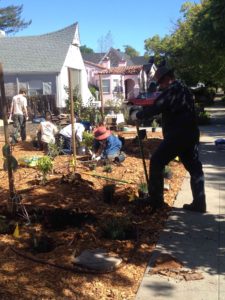
Digging swales at Enchanted Garden, Day 3 of installations.
Before April, I had never dug a swale in my life. The thought of redirecting downspouts and digging swales was intimidating, as was the wonder and worry about what to plant where. Participating at the Enchanted Cottage Garden installation in Vallejo changed that, because it helped create the muscle knowledge of digging, filling and planting an actual food forest. With so many people involved, the work was fast and fun, and I picked up so many tips on creating a swale, laying sheet mulch, and planting trees, edibles and beneficial plants.
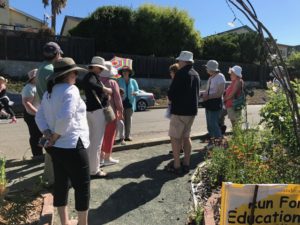
Food Forest Keeper Heather welcomes a tour group at the 7 Food Forest Tour on May 20th.
Seeing a garden at its very beginning was one experience, and the May 20 tour of seven gardens in Benicia showed what can happen in a year or two. Trees had flourished, producing fruit, and vines of raspberries threatened to take over their designated corners. In some cases, certain plants had not survived conditions that were too wet or too dry — and the forest keepers who owned and shared their gardens talked about relocating, replacing and replanting. Often the refrain came up that the gardens were “sink or swim” with plants best suited to the tops of hills, the sunny spots or the wetter spots given their chance to settle in and grow, but not coddled or forced.
One thing I’ve also learned that is just as valuable as any landscape or plant knowledge: There is a community of pretty amazing people doing this.
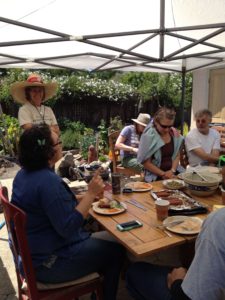
Sharing lunch and each other’s company on Installation Day 2 at The Ripple Effect.
During the time spent on the Enchanted Cottage Garden, I got to know the other volunteers, hear about what they were doing in their own homes and why they were volunteering on the project. We talked greywater and plants, but also about neighbors and community. I was sad to say goodbye on the last day and hope to reconnect at future events and projects.
In Benicia, each forest keeper who opened their gates to those of us on the tour was open and welcoming in discussing their gardens, offering up plants and offering advice. They shared how often they water their fruit trees, what struggled in one location and thrived in another, how they collected and let their gardens self-seed or how they were taking the ideas from their food forests and translating them into other parts of their yard. I spoke with some about how sharing the garden’s bounty with neighbors has fostered a stronger sense of community.
I left that tour with notes on each garden, a rough sketch of ideas for my own yard and a pivot in what I want to focus on first, moving my ambitions from the backyard to the front with what we might be able to start planting that could draw in neighbors (though, trust me, I certainly have plans for the backyard, too).
And, whether it’s finding a local source for wood chips, floating a question about plants or seeking out programs to further my own understanding, I know that there is Sustainable Solano and this community of keepers always there to help.
Apr 24, 2017
Learn about the plots, the schedules for the days, the families involved, and dive in to our community installation event!
The future Vallejo Demonstration Food Forests
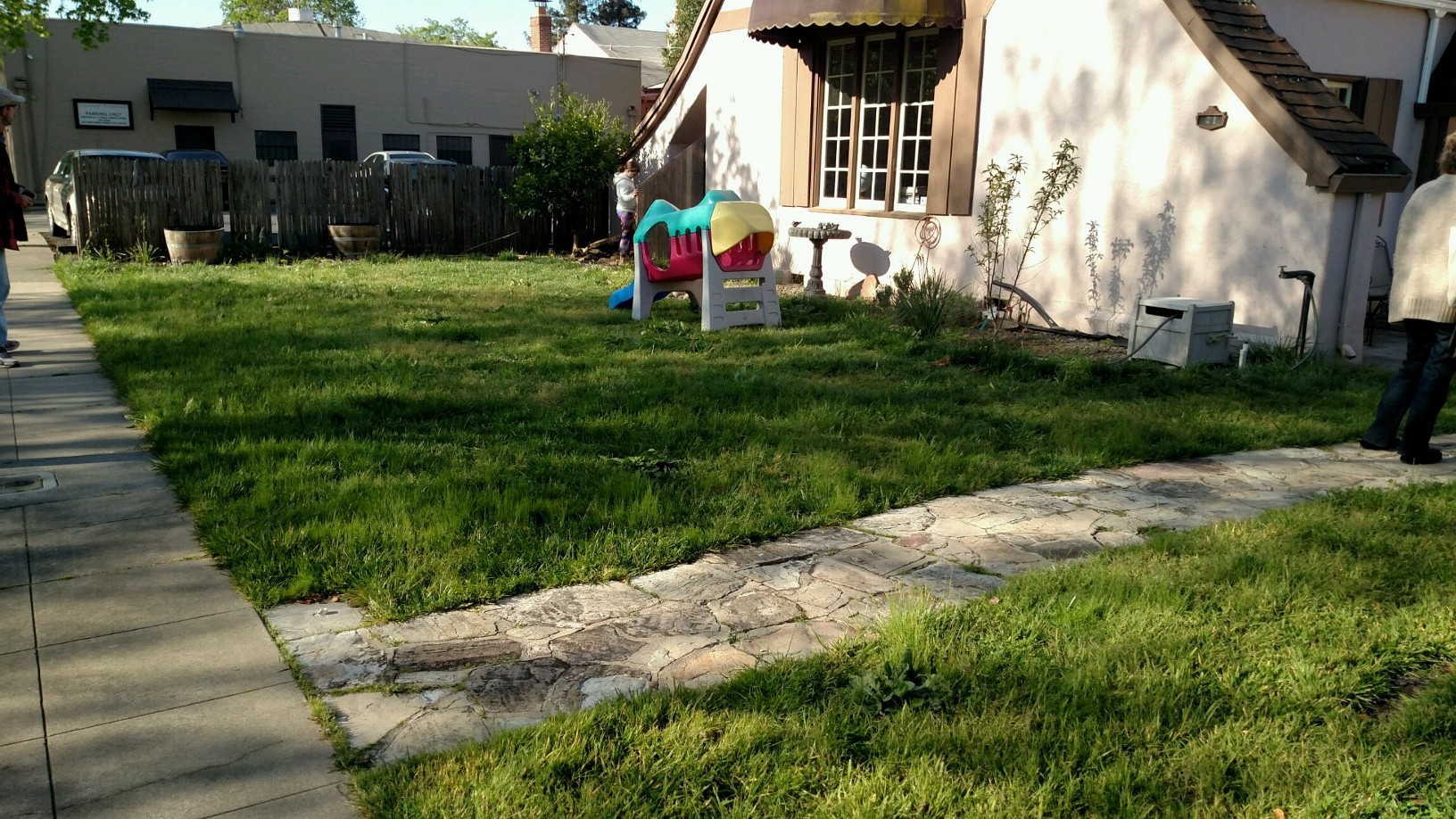
The Enchanted Cottage Garden
The Enchanted Cottage Garden is a water-sucking, plain lawn that wants to become so much more for its family and its neighborhood! Join us in sheet mulching the lawn (the quickest way to replace a lawn–and provides great nutrients for the garden too!), and learning about the permaculture design we have to install a food forest here, incorporating the needs of a family with children, and their love of canning.

The Ripple Effect
The Ripple Effect is a work in process, already sheet-mulched to remove a lawn, with creative materials re-use, fruit trees, people space and many edibles and pollinators. Join us in adding in the extra laundry-to-landscape element and planting a fruit tree guild to showcase and add the 7-layer permaculture food forest aspect to this space to help it, and its owner, realize its full potential.
Installation Day Schedules
Enchanted Cottage Garden – Day 1
- 9:00AM Registration with coffee and snacks
- 9:30AM-10:30AM Presentation of designs and concepts
- 10:30AM-12:00PM Creating groundwater retention and storage with swales
- 12:00PM-1:00PM Lunch, provided by the hosts
- 1:00PM-3:00PM Planting of fruit trees
- 3:00PM-4:00PM Sheet mulching the lawn
The Ripple Effect – Day 2
- 9:00AM Registration with coffee and snacks
- 9:30AM-11:00AM Presentation of designs and greywater concepts
- 11:00AM-1PM Split into two groups: Group 1 hands on pipe installation at laundry, Group 2 preparation of mulch basins and running lines to target plants in yard.
- 1:00PM-2:00PM Lunch, provided by the host
- 2:00PM-4:00PM Switch Group locations to finish inside/outside greywater so that everyone can have experience with the whole process
Enchanted Cottage Garden – Day 3
- 9:00AM Registration with coffee and snacks
- 9:30AM-10:30AM Presentation of designs and concepts
- 10:30AM-12:00PM Planting
- 12:00PM-1:00PM Lunch, provided by the hosts
- 1:00PM-4:00PM Drip Irrigation basics: learning about and testing water-efficient drip irrigation to plants
This is a rough schedule, which may change due to weather, location, and volunteer interests/questions!
About the Food Forest Keepers
 Introducing Julie
Introducing Julie
Julie is the keeper at The Ripple Effect, with hopes that health and happiness will ripple out from her garden. When she bought her house 2.5 years ago, she had three goals: build the soil, plant a diverse plant community for a thriving ecosystem, and get rid of the grass! She’s got a ton of projects going on, such as perhaps converting a shed into a chicken coop, improving the vacant lot next door, a mushroom farm…and re-using water with a greywater system!
She dreams of a green, caring, diverse world. Inclusive, Thriving. A little bit more unplugged. Homemade music. Poetry. Block parties. Clean water. Clean Air. Oil-free lifestyles. Walkable welcoming farmed urban areas. Aesthetic beauty in downtown areas. GREAT affordable public transportation. Lots more ferries on the SF Bay: Vallejo to the East Bay as well as San Francisco. Front porch checker games. Kids playing in the streets and cars slowing down. Perhaps a labyrinth or two in every town…
 Introducing Melissa and Steve & Family
Introducing Melissa and Steve & Family
Melissa, Steve and Maya (9) and Jacob (15)–shown in the picture–are the food forest keepers at Enchanted Cottage Garden. They have a small plot in the backyard with chickens, and have been wanting to grow more food for some time. They enjoy cooking and canning so would love a place for more herbs and veggies. They envision taking out the front lawn and putting in food plants and pollinators for insects.
They hope their yard will be a source of inspiration for others as well as a comfortable place for neighbors to gather. They live near a high school and kids often come by their house. They would like their own children to be more connected to nature. Melissa and Steve are lifelong Vallejoans and find it rewarding to give back to the community–through scouting, Participatory Budgeting, lemonade stands for pediatric cancer, and more. They are looking forward to welcoming the community to their come and combining the spirit of giving with their personal hobbies of cooking, canning, and chickens.
Apr 24, 2017
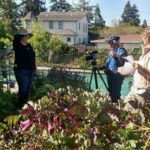
Heather Pierini, Landscape Architecture student at UC Davis and Birds, Bees & Beyond Food Forest Keeper, speaks on camera
Over the weekend, Sustainable Solano, with our wonderful Constance Beutel as camera-woman and director, shot scenes for a Water-Wise documentary video. The video was shot at Birds, Bees & Beyond, one of the Demonstration Food Forests, with commentary from Executive Director Elena Karoulina, Sustainable Landscaping Advisory Board Member Kathleen Huffman, and food forest keeper Heather Pierini.
Sometimes pictures tell a story better than a thousand words. This might be the case – the film shows the three components of our Wise Water approach – rainwater collection in the ground, roofwater diversion to the ground and L2L greywater. You’ll be able to see how these systems were put together and an amazing difference this secondary water makes in this garden. We will use the film for training, presentation, and inspiration. Stay tuned for its release!
Apr 9, 2017
On Sunday, April 2, as a part of the Benicia Sustainable Backyard program, about ten people gathered at a Benicia house for the final (for now) 2017 laundry-to-landscape hands-on greywater installation workshop. The host for the day was Mayor of Benicia Elizabeth Patterson, a supporter of sustainable use of water. There was a great group of participants from Vallejo and Benicia. A special group of attendees who had applied for the Vallejo Sustainable Backyard demonstration food came to learn both about greywater and about how the workshop was run as an educational experience.
The instructors from Greywater Action, Christina and Jessica, explained current regulation regarding greywater (you do not need a permit in California to install a simple, gravity-fed laundry to landscape system), and different parts of the system: the indoor – laundry three-way valve that will regulate the flow of laundry water to landscape, and the outdoor part – a pipe that will direct greywater to a few mulch basins placed next to the large trees in Elizabeth’s front yard. The group then split in two: half of the participants began installing a three-way valve, while the second half rolled out the water pipe and began digging. The groups changed places after lunch so everyone would get a hands-on experience on every aspect of installation. It took some tweaking and adjusting, but finally the water from the washing machine was flowing evenly to all mulch basins. Now this mature front-yard landscape has a reliable source of water, rain or shine!
Thank you, Mayor Patterson, for volunteering your house for a public workshop!
Mar 1, 2017
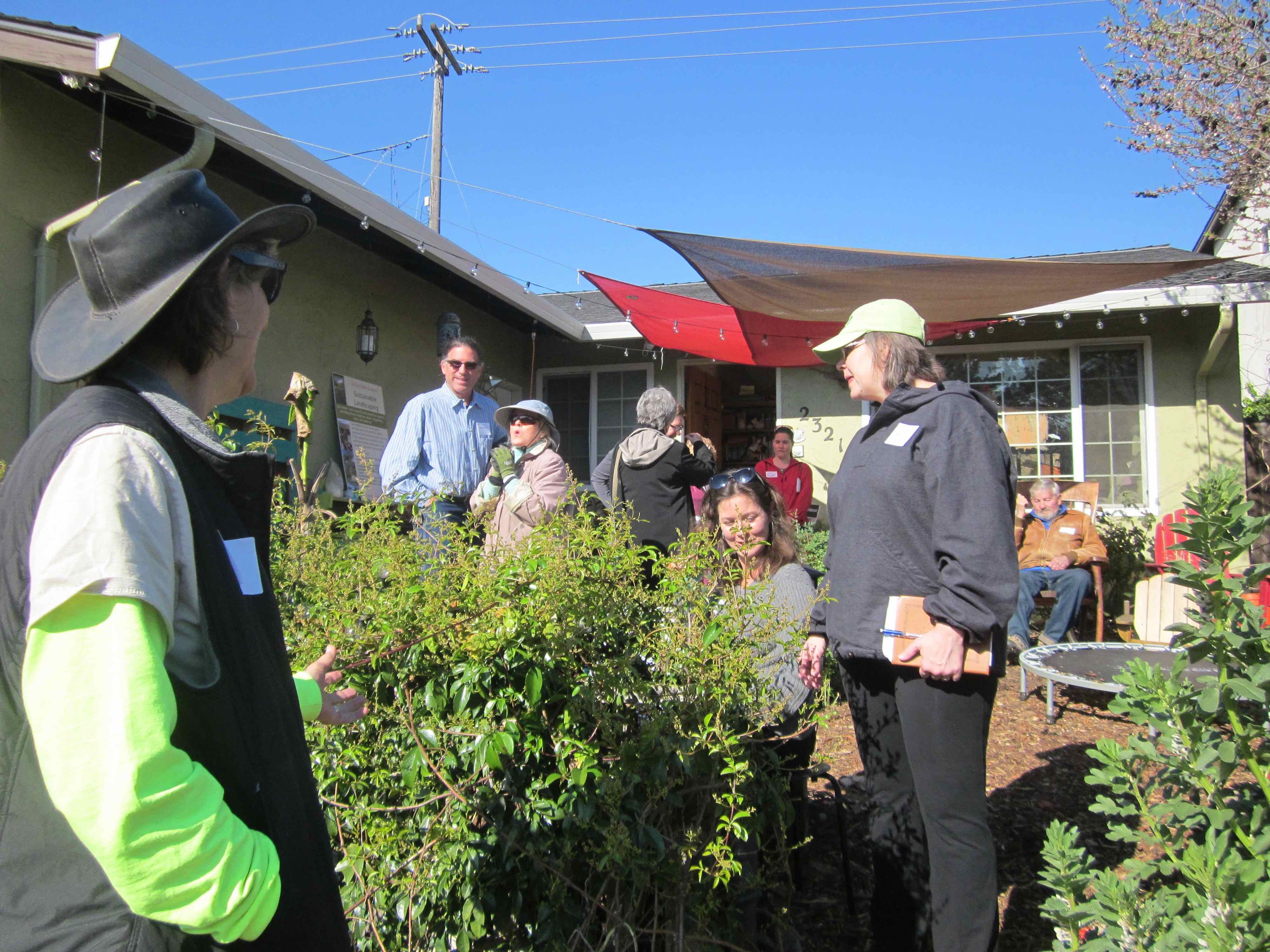
It was a cool and sunny day for the Greyhawk Grove Tour, and perhaps it was that, or that our tour is gathering steam, that nearly 30 people squeezed into a room to listen to Lydia Neilsen from the Regenerative Design Institute. She started with a brief overview of permaculture design principles: people care, earth care–and then dove straight into practical, simple applications to one’s garden, covering hands-on details of creating swales (or as someone coined them, “Magical ditches”), appreciating weeds and the natural succession of plant life, and mimicking that healthy ecosystem balance in tree and plant guilds. She fielded questions about greywater, and, noting that several Food Forest Keepers were in attendance, had them field questions as well. Attendees remarked on on simple, clear, and practical her talk was.
The overflowing group then spilled out into the demonstration food forest itself, were Lydia pulled up a giant fava bean to show the group the roots and speak about cover crops, nitrogen fixation and soil health. She also ate a nodule, declaring it tasted like peanuts and offered it to anyone who wanted to try. They were able to see the laundry-to-landscape switch and pipes, look at the greywater basins, the rainwater pipes that flowed straight into the two swales, how the natural slope and chicken coop was incorporated into the planning, and snuggle up the free range chickens who were milling about. “We used to have one of these at the farm,” said the farm director of Loma Vista Farms after she cuddled up a polish chicken–known for a mop of feathers on top of its head that looks like punk-rocker hair. “We used to call it our Tina Turner chicken. But now the kids don’t get the reference. I guess rockstar chicken still works.”
It was a rockstar day all around. And we look forward to the next stop in the tour–stop #6, “The Curious Garden.”
For more information and to register for “The Curious Garden”, please go here.
Jan 30, 2017
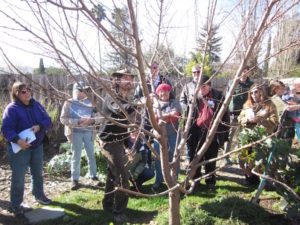
David Shaw of Santa Cruz Permaculture’s talk and tour turned into an extended one when the official event ended. Due to enthusiasm the talk portion ran long and the tour ran out of time. Attendees still had many questions, so David graciously agreed to travel directly to the Community Orchard where he continued answering pruning-related questions. As one participant noted, “That was so killer. I think I’ll be taking David’s permaculture course.”
What he was referring to was David’s quick overview of permaculture principles. What was an hour talk with handouts quickly blossomed into a nearly 2-hour one, complete with poetry recitation, and an explanation of how permaculture was similar and different to academic-based agro-ecology (he teaches at UC Santa Cruz in agro-ecology as well), and Q&A. There were over two dozen attendees, with several steadily streaming in after the talk began, and space became so limited that attendees joked about huddling together on the “huddle corner” of the living room couch, attendees sat on the floor and on pillows, and many stood.
The tour portion of the day commenced with only 15 minutes left, but the hosts Kirsten and Nick were amenable, and curious to learn about pruning their lovely fruit trees, so they extended the tour by half an hour. Yet even running half an hour over, attendees were delighted when David agreed to continue the talk at the Community Orchard and expressed his wish to stay for lunch and see more of the town.
Permaculture isn’t just about plants and trees, the self-proclaimed tree nerd and orchardist said, it is about community, resilience, and re-energizing. When someone asked why he didn’t use the word sustainability, he countered with a brief anecdote: “Well, look, if someone asks you about your marriage, would you want to say, ‘It’s sustainable’ or would you want to say, ‘It’s renewing and re-generative?'” And it seemed that many of the people who attended the even found it very much so.
Please note: For those still interested in a more in-depth workshop on pruning, the Community Orchards is hosting Ann Ralph of Grow a Little Fruit Tree on February 11th. The workshop is free from orchard members, $40 for non-members. There is a 20 person limit. More information and registration can be found here.
Our next stop is February 25th, at “Greyhawk Grove”, another one of our original installation food forests, with Lydia Neilson of the Regenerative Institute. The event is FREE, but you must pre-register for the location. More information can be found here.






 Introducing Julie
Introducing Julie Introducing Melissa and Steve & Family
Introducing Melissa and Steve & Family



